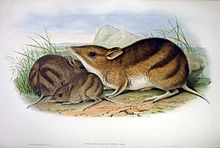Tasmanian long-nosed butler
| Tasmanian long-nosed butler | ||||||||||||
|---|---|---|---|---|---|---|---|---|---|---|---|---|

Tasmanian long-nosed butler |
||||||||||||
| Systematics | ||||||||||||
|
||||||||||||
| Scientific name | ||||||||||||
| Perameles gunnii | ||||||||||||
| Gray , 1838 |
The Tasmanian long-nosed sacrum ( Perameles gunnii ) is a marsupial from the family common nasal sac that occurs in Tasmania and mainland Australia .
features
The species has pointed ears and a long snout, the abdomen appears compact. The fur is sandy brown to gray on the upper side, and lighter to whitish on the belly and legs. The animals are characterized by several bright bands on their abdomen. The tip of the nose is pink and almost bare. The Tasmanian nose bag reaches a head-trunk length of 27 to 35 cm, a tail length of 7 to 11 cm and a weight of 0.5 to 1.5 kg.
Distribution and habitat
The Tasmanian nose purse lives today mainly in eastern and northern Tasmania. It originally had a larger distribution area in southeast Australia. Due to several unfavorable factors, this population became temporarily extinct. In recent years the species has been reintroduced in various locations in the state of Victoria .
As Habitat serve grasslands and wooded areas with grass as a vegetation.
Way of life

The individual animals live alone outside of the mating season. They are mainly nocturnal and rest in self-made nests made of grass, leaves and twigs, which are placed on the ground in the protection of dense vegetation. Sometimes abandoned rabbit holes are used as hiding places. The average territory size is 40 hectares for males and 30 hectares for females. The territories can overlap but each nest is only used by one adult specimen. The Tasmanian nosebug digs with its claws and pointed snout in the ground in search of earthworms, beetles , insect larvae and other invertebrates . It also eats berries, roots, grain and other parts of plants.
Females are ready to mate up to four times a year. In Tasmania, reproduction occurs between late May and December. After about 12 days of gestation , two young animals are usually born, rarely up to four young. These climb into the mother's pouch, where they remain for 55 to 60 days. After leaving the bag, they will be suckled for about a week. When they reach sexual maturity , the animals are around four months old.
The Tasmanian nose purse can live to be three years old.
status
After the arrival of the Europeans in Australia, the situation of the Tasmanian nose purse deteriorated rapidly. The original grassy areas were now used as pasture for sheep or converted into arable land. As a result, the species lost almost 99% of its original habitat. In addition to the already existing dingo , new enemies in the form of domestic cats and foxes were added. Introduced rabbits presented new competition.
To preserve the species on the mainland, breeding programs have been started and several specimens have been released into the wild. Even so, the population in Victoria only consists of a few hundred animals. The Tasmanian nose purse is still quite common in Tasmania. The IUCN therefore lists the entire population in the early warning list ( Near Threatened ).
Individual evidence
- ↑ a b c d e f g John Rodger: Eastern barred bandicoot ( Engl. ) ARKive. November 27, 2007. Archived from the original on October 19, 2012. Info: The archive link was automatically inserted and has not yet been checked. Please check the original and archive link according to the instructions and then remove this notice. Retrieved April 13, 2013.
- ↑ a b c d Perameles gunnii in the endangered Red List species the IUCN 2011. Posted by: Menkhorst, P. & Richards, J., 2008. Accessed April 13, 2013.
- ↑ a b c d E. Lancaster: Perameles gunnii ( English ) Animal Diversity Web. 2001. Retrieved April 13, 2013.
